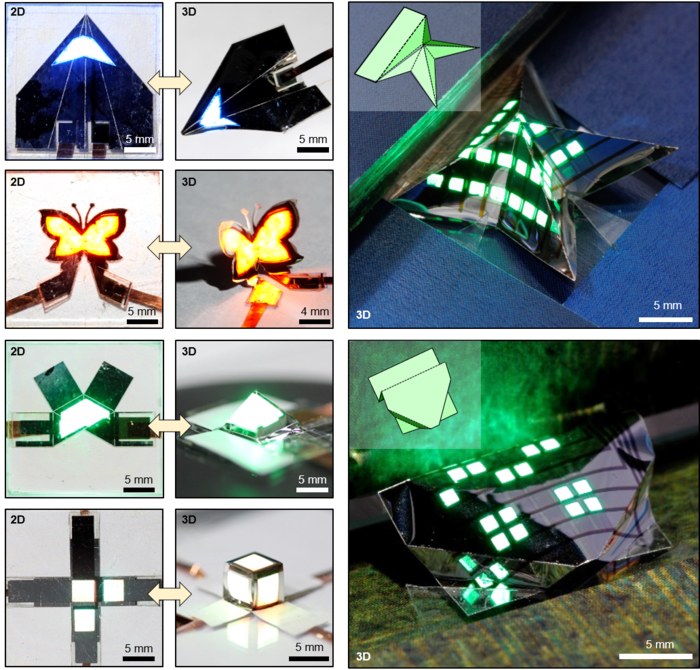QLEDs that fold like origami

Korean researchers develop 3D foldable variant of ultrathin quantum dot LED
A research team led by Kim Dae-Hyeong and Hyeon Taeghwan at Seoul National University's Center for Nanoparticle Research has developed a foldable variant of an ultrathin quantum dot LED (QLED), inspired by the ancient art of paper folding known as origami.
The researchers reported 3D foldable QLEDs, which can be freely transformed into various user-customised 3D structures, such as butterflies, airplanes, and pyramids. Considering the rising popularity of foldable smartphones, the advancement of foldable display technology is gaining greater importance.
The researchers endowed foldability to the conventional planar QLED via a new fabrication process that can partially etch the epoxy film deposited on the QLED surface without damaging the underlying QLED. Using a power-controllable carbon dioxide pulsed laser and the silver-aluminum alloy-based etch-stop layers, the etching depth can be precisely controlled. As the laser-etched part of the device is relatively thinner than the surrounding region, it is possible to etch out deformation lines along which the device can be folded like origami paper.
Based on the selective laser-etching technique, researchers were able to precisely control the radius of curvature down to less than 50 micrometers. Under such a small curvature radius, the fold line resembles a sharp edge with no visible curvature. By using mechanical simulation to carefully engineer the device, researchers were able to minimise the strain loaded on the light-emitting components. The entire QLED including the crease region (a fold line) was able to maintain a stable light-emitting performance even when after it was repeatedly folded 500 times. The technology was applied to fabricate 3D foldable QLEDs with various complex shapes such as butterflies, airplanes, and pyramids.
“We were able to build a 3D foldable QLED that can be freely folded just like a paper artwork”, said Kim Dae-Hyeong, the vice-director of the Center for Nanoparticle Research. He also said, “By fabricating the passively driven, 3D foldable QLED arrays composed of 64 individual pixels, we have shown the possibility of developing displays with greater complexity in the future.”
Hyeon Taeghwan, the director of the Center for Nanoparticle Research, states that “Through the technology reported in this research, paper-like QLEDs that can be folded into various complex structures have been successfully fabricated. Who knows when the day will come when electronic paper with a display unit can replace real paper?”
'Three-dimensional foldable quantum dot light-emitting diodes' by Dong Chan Kim et al; Nature Electronics volume 4 (2021)


































